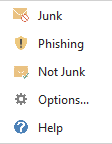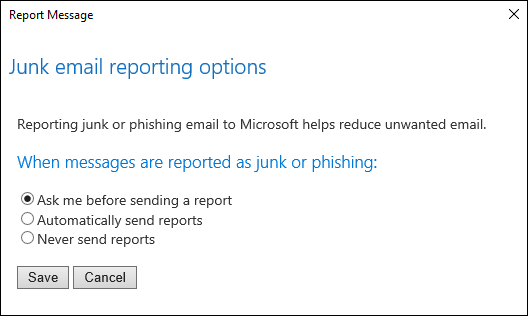The Report Message add-in works with Outlook to allow you to report suspicious messages to Microsoft as well as manage how your Microsoft 365 email account treats these messages.

Messages that your Microsoft 365 email account marks as junk are automatically moved to your Junk Email folder. However, spammers and phishing attempts are continually evolving. If you receive a junk email in your inbox, you can use the Report Message add-in to send the message to Microsoft to help us improve our spam filters. If you find an email in your Junk Email folder that’s not spam, you can use the Report Message add-in to mark it as a legitimate email, move the message to your Inbox, and report the false positive to help Microsoft refine their filters.
How to Identify SPAM?
Please see our guide here: How to check if a suspicious email is safe
Report Message Outlook Add-in
Report a message
If you choose the Report Message button on the ribbon, you’ll see several different options.

If you choose Junk, Phishing, or Not Junk, you’ll have the option to send a copy of the message to Microsoft, along with your classification of the message. This is optional. To turn off the option to send a copy of the message to Microsoft, choose Options and then follow the steps listed under Report Message add-in options shown below.
What’s Junk email?
Junk email messages are typically referred to as spam. These are messages that you don’t want to receive that may be advertising products you don’t use or find offensive. If you choose the Junk option, a copy of the message may be sent to Microsoft to help update our spam filters, and the message will be moved from your Inbox to your Junk Email folder.
What’s phishing?
Phishing is the practice of luring you into disclosing personal information, such as bank account numbers and passwords. Often phishing messages look legitimate, but have deceptive links that actually open fake websites. If you select Phishing, a copy of your message may be sent to Microsoft to help update our filters, and the message will be moved from your Inbox to your Junk Email folder.
What’s a legitimate email?
If you know the sender and you’re expecting the message, or if you receive a message that’s mistakenly marked as junk, you can use the Report Message add-in to mark the message as Not Junk. This will move the message from the Junk Email folder back to your Inbox.
Report Message add-in options
Choosing Options from the Report Message button allows you to choose whether messages are automatically sent to Microsoft when they’re reported as junk or phishing attempts.
Change your Report Message options
- Choose Options from the Report Message button on the Ribbon.

- Select one of the following options:
- Always send a copy of the message to Microsoft
- Never send a copy of the message to Microsoft
- Ask before sending a copy of the message to Microsoft
- Once you’ve made your selection, choose Save. You’ll see the following message in the InfoBar in the message header confirming your changes were saved successfully.

- Options settings are cached with the message, so in order to see your updated setting, you’ll need to select a new message first.
- If your version of Outlook doesn’t support the Options setting, you’ll see a notification message that directs you to https://aka.ms/ReportMessageOptions.
Reporting An Email Without The Add-in
Sometimes you cannot use the Report Message Add-in (shared mailboxes do not support it). In these instances, you can still report the message directly to Microsoft by following the below steps:

